Internet of Things and Privacy
VerifiedAdded on 2021/05/31
|10
|2426
|144
AI Summary
Running Head: THE INTERNET OF THINGS AND PRIVACY 1 THE INTERNET OF THINGS AND PRIVACY6 INTERNET OF THINGS AND PRIVACY Student Name Institutional Affiliation Facilitator Course Date Internet of Things and Privacy The Internet of Things refers to the network of physical devices which generally include the home appliances and some other items which are embedded with sensors, software, actuators, electronics, and the connectivity which enables the embedded items to connect directly and exchange data (Atzori, Iera&Morabi
Contribute Materials
Your contribution can guide someone’s learning journey. Share your
documents today.
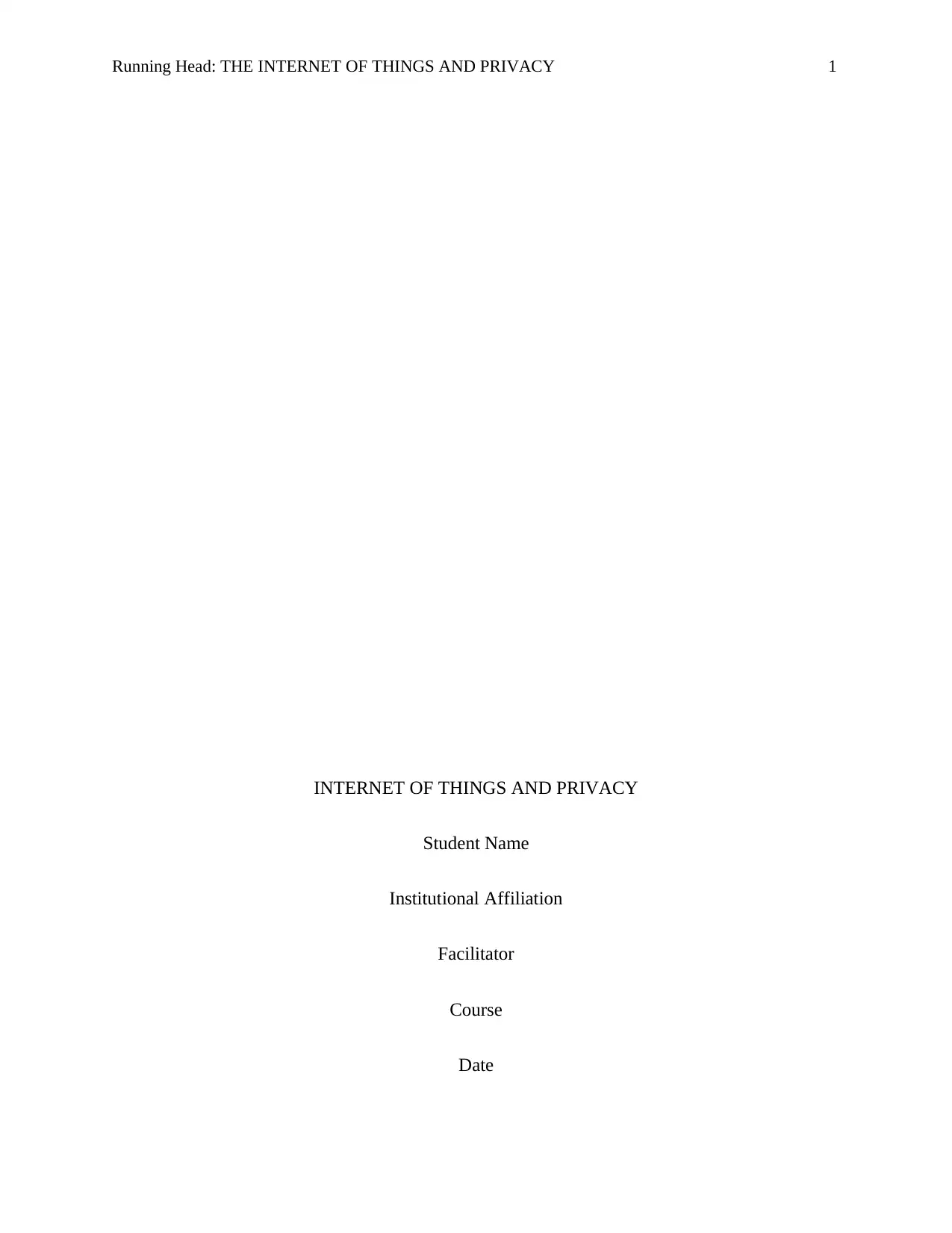
Running Head: THE INTERNET OF THINGS AND PRIVACY 1
INTERNET OF THINGS AND PRIVACY
Student Name
Institutional Affiliation
Facilitator
Course
Date
INTERNET OF THINGS AND PRIVACY
Student Name
Institutional Affiliation
Facilitator
Course
Date
Secure Best Marks with AI Grader
Need help grading? Try our AI Grader for instant feedback on your assignments.
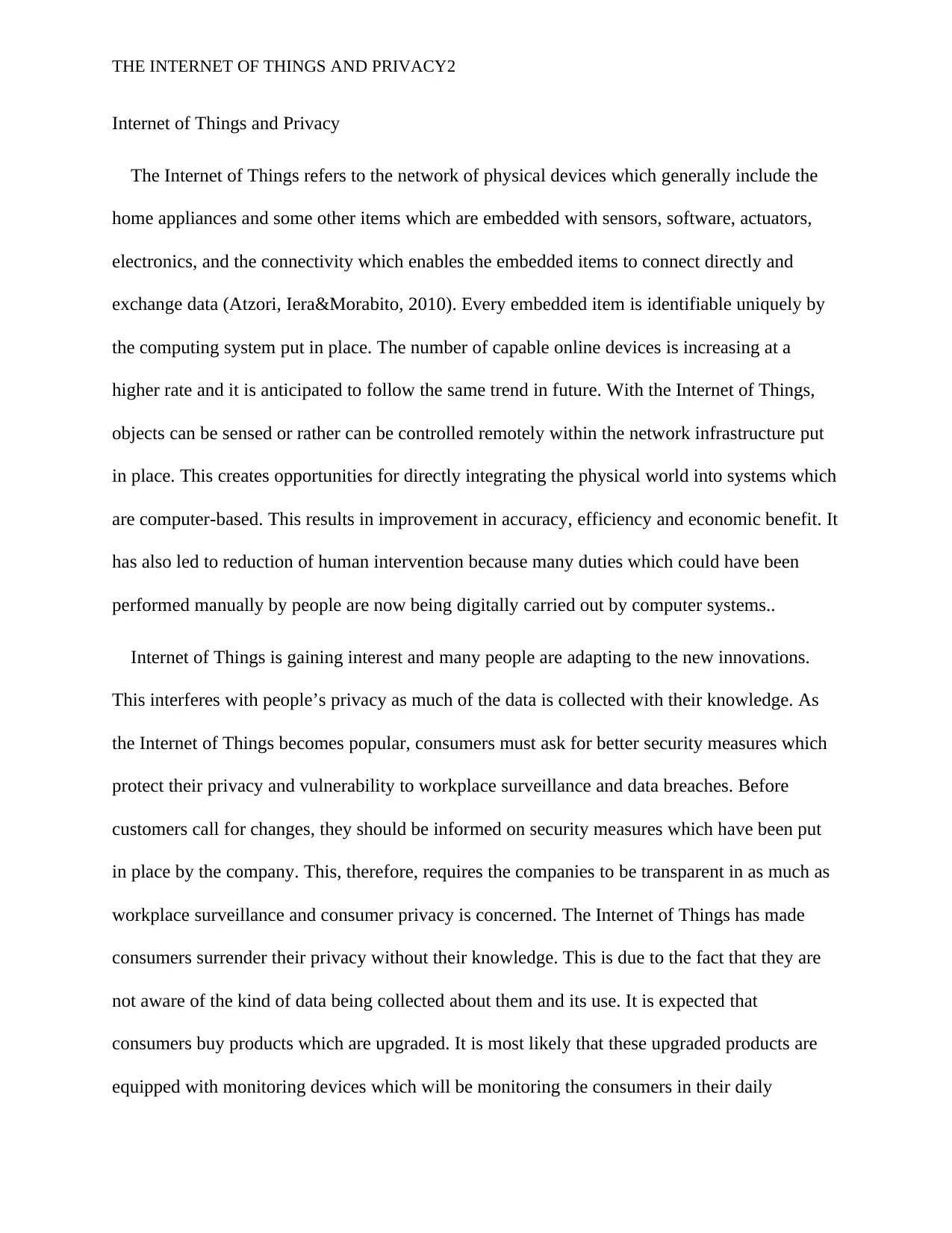
THE INTERNET OF THINGS AND PRIVACY2
Internet of Things and Privacy
The Internet of Things refers to the network of physical devices which generally include the
home appliances and some other items which are embedded with sensors, software, actuators,
electronics, and the connectivity which enables the embedded items to connect directly and
exchange data (Atzori, Iera&Morabito, 2010). Every embedded item is identifiable uniquely by
the computing system put in place. The number of capable online devices is increasing at a
higher rate and it is anticipated to follow the same trend in future. With the Internet of Things,
objects can be sensed or rather can be controlled remotely within the network infrastructure put
in place. This creates opportunities for directly integrating the physical world into systems which
are computer-based. This results in improvement in accuracy, efficiency and economic benefit. It
has also led to reduction of human intervention because many duties which could have been
performed manually by people are now being digitally carried out by computer systems..
Internet of Things is gaining interest and many people are adapting to the new innovations.
This interferes with people’s privacy as much of the data is collected with their knowledge. As
the Internet of Things becomes popular, consumers must ask for better security measures which
protect their privacy and vulnerability to workplace surveillance and data breaches. Before
customers call for changes, they should be informed on security measures which have been put
in place by the company. This, therefore, requires the companies to be transparent in as much as
workplace surveillance and consumer privacy is concerned. The Internet of Things has made
consumers surrender their privacy without their knowledge. This is due to the fact that they are
not aware of the kind of data being collected about them and its use. It is expected that
consumers buy products which are upgraded. It is most likely that these upgraded products are
equipped with monitoring devices which will be monitoring the consumers in their daily
Internet of Things and Privacy
The Internet of Things refers to the network of physical devices which generally include the
home appliances and some other items which are embedded with sensors, software, actuators,
electronics, and the connectivity which enables the embedded items to connect directly and
exchange data (Atzori, Iera&Morabito, 2010). Every embedded item is identifiable uniquely by
the computing system put in place. The number of capable online devices is increasing at a
higher rate and it is anticipated to follow the same trend in future. With the Internet of Things,
objects can be sensed or rather can be controlled remotely within the network infrastructure put
in place. This creates opportunities for directly integrating the physical world into systems which
are computer-based. This results in improvement in accuracy, efficiency and economic benefit. It
has also led to reduction of human intervention because many duties which could have been
performed manually by people are now being digitally carried out by computer systems..
Internet of Things is gaining interest and many people are adapting to the new innovations.
This interferes with people’s privacy as much of the data is collected with their knowledge. As
the Internet of Things becomes popular, consumers must ask for better security measures which
protect their privacy and vulnerability to workplace surveillance and data breaches. Before
customers call for changes, they should be informed on security measures which have been put
in place by the company. This, therefore, requires the companies to be transparent in as much as
workplace surveillance and consumer privacy is concerned. The Internet of Things has made
consumers surrender their privacy without their knowledge. This is due to the fact that they are
not aware of the kind of data being collected about them and its use. It is expected that
consumers buy products which are upgraded. It is most likely that these upgraded products are
equipped with monitoring devices which will be monitoring the consumers in their daily
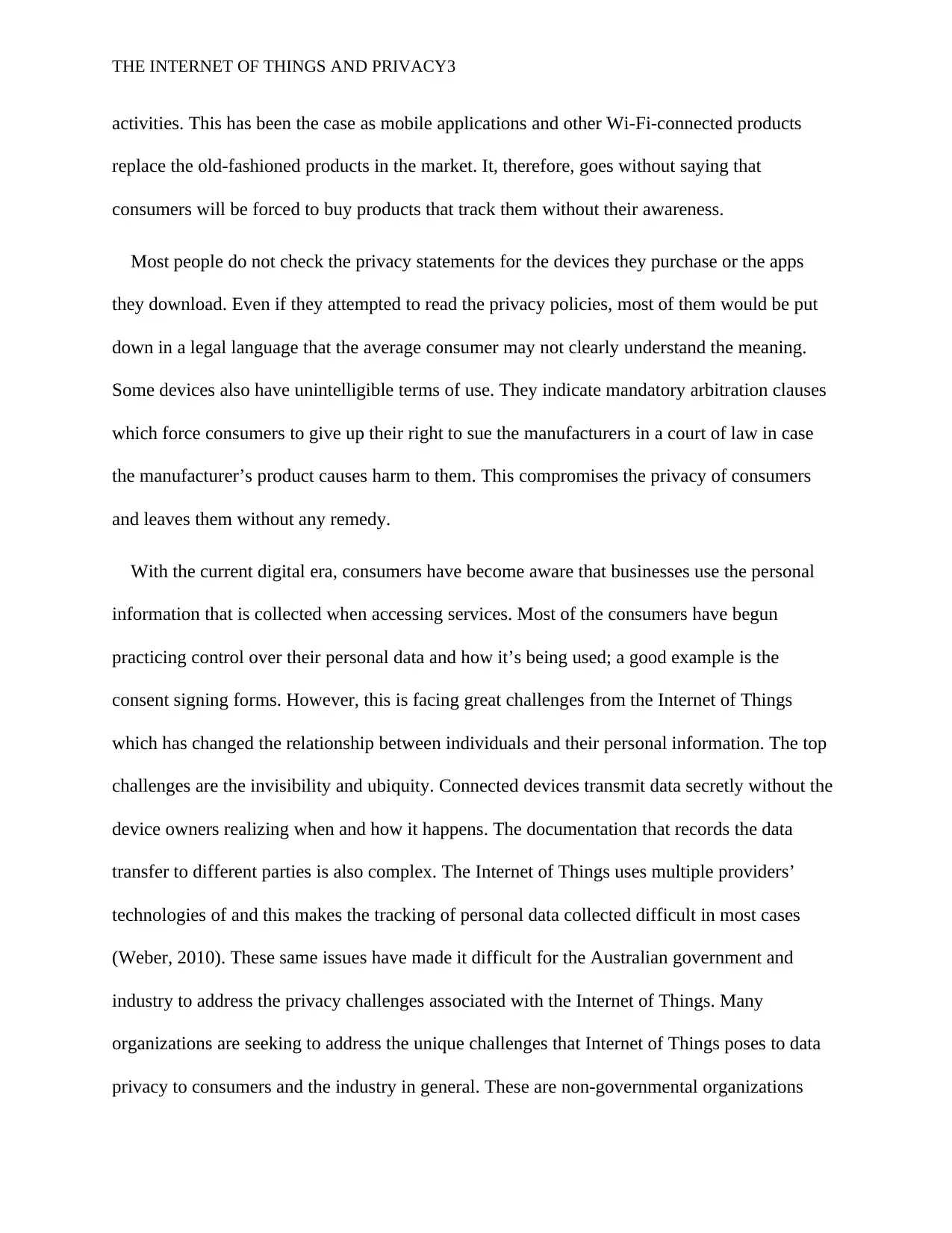
THE INTERNET OF THINGS AND PRIVACY3
activities. This has been the case as mobile applications and other Wi-Fi-connected products
replace the old-fashioned products in the market. It, therefore, goes without saying that
consumers will be forced to buy products that track them without their awareness.
Most people do not check the privacy statements for the devices they purchase or the apps
they download. Even if they attempted to read the privacy policies, most of them would be put
down in a legal language that the average consumer may not clearly understand the meaning.
Some devices also have unintelligible terms of use. They indicate mandatory arbitration clauses
which force consumers to give up their right to sue the manufacturers in a court of law in case
the manufacturer’s product causes harm to them. This compromises the privacy of consumers
and leaves them without any remedy.
With the current digital era, consumers have become aware that businesses use the personal
information that is collected when accessing services. Most of the consumers have begun
practicing control over their personal data and how it’s being used; a good example is the
consent signing forms. However, this is facing great challenges from the Internet of Things
which has changed the relationship between individuals and their personal information. The top
challenges are the invisibility and ubiquity. Connected devices transmit data secretly without the
device owners realizing when and how it happens. The documentation that records the data
transfer to different parties is also complex. The Internet of Things uses multiple providers’
technologies of and this makes the tracking of personal data collected difficult in most cases
(Weber, 2010). These same issues have made it difficult for the Australian government and
industry to address the privacy challenges associated with the Internet of Things. Many
organizations are seeking to address the unique challenges that Internet of Things poses to data
privacy to consumers and the industry in general. These are non-governmental organizations
activities. This has been the case as mobile applications and other Wi-Fi-connected products
replace the old-fashioned products in the market. It, therefore, goes without saying that
consumers will be forced to buy products that track them without their awareness.
Most people do not check the privacy statements for the devices they purchase or the apps
they download. Even if they attempted to read the privacy policies, most of them would be put
down in a legal language that the average consumer may not clearly understand the meaning.
Some devices also have unintelligible terms of use. They indicate mandatory arbitration clauses
which force consumers to give up their right to sue the manufacturers in a court of law in case
the manufacturer’s product causes harm to them. This compromises the privacy of consumers
and leaves them without any remedy.
With the current digital era, consumers have become aware that businesses use the personal
information that is collected when accessing services. Most of the consumers have begun
practicing control over their personal data and how it’s being used; a good example is the
consent signing forms. However, this is facing great challenges from the Internet of Things
which has changed the relationship between individuals and their personal information. The top
challenges are the invisibility and ubiquity. Connected devices transmit data secretly without the
device owners realizing when and how it happens. The documentation that records the data
transfer to different parties is also complex. The Internet of Things uses multiple providers’
technologies of and this makes the tracking of personal data collected difficult in most cases
(Weber, 2010). These same issues have made it difficult for the Australian government and
industry to address the privacy challenges associated with the Internet of Things. Many
organizations are seeking to address the unique challenges that Internet of Things poses to data
privacy to consumers and the industry in general. These are non-governmental organizations
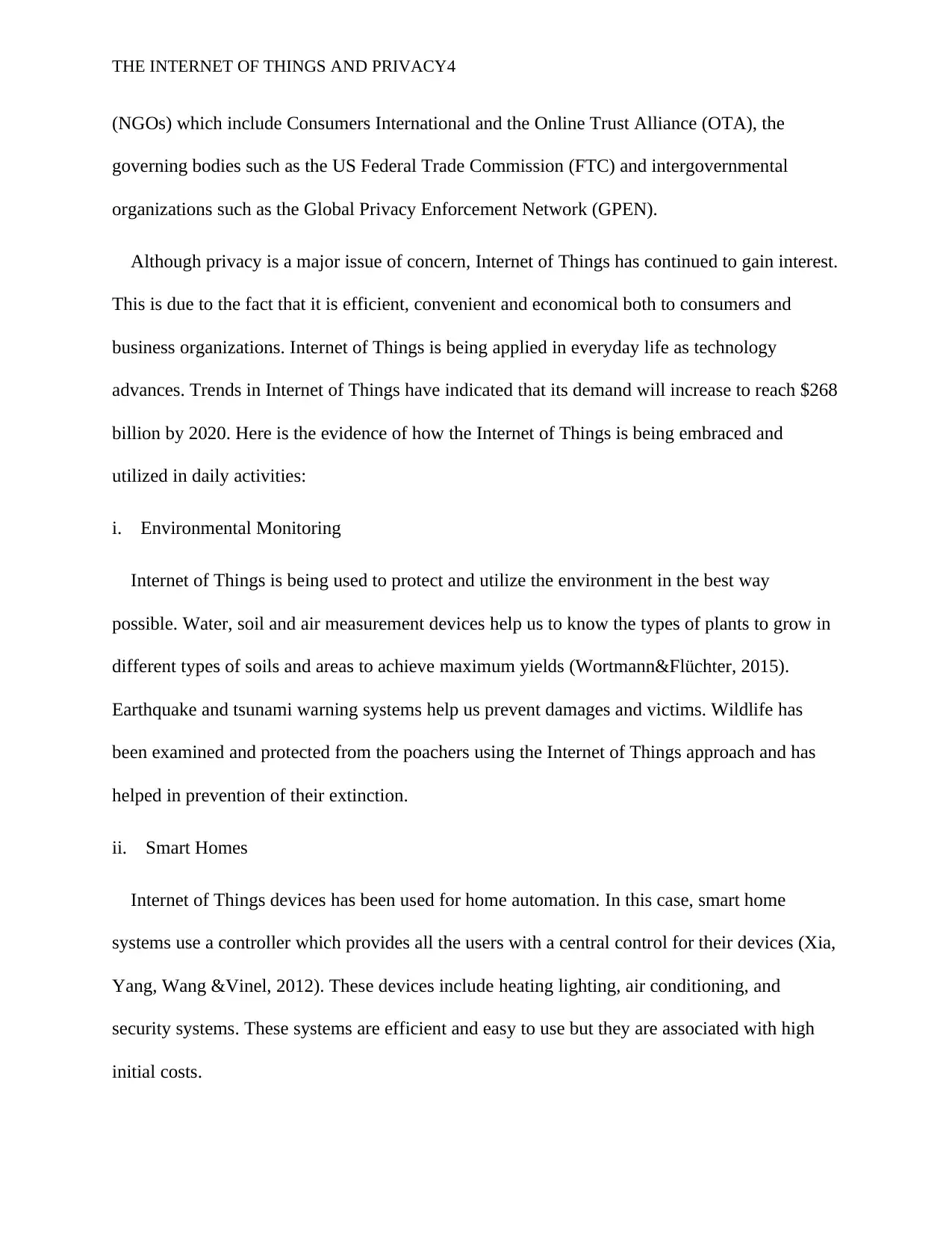
THE INTERNET OF THINGS AND PRIVACY4
(NGOs) which include Consumers International and the Online Trust Alliance (OTA), the
governing bodies such as the US Federal Trade Commission (FTC) and intergovernmental
organizations such as the Global Privacy Enforcement Network (GPEN).
Although privacy is a major issue of concern, Internet of Things has continued to gain interest.
This is due to the fact that it is efficient, convenient and economical both to consumers and
business organizations. Internet of Things is being applied in everyday life as technology
advances. Trends in Internet of Things have indicated that its demand will increase to reach $268
billion by 2020. Here is the evidence of how the Internet of Things is being embraced and
utilized in daily activities:
i. Environmental Monitoring
Internet of Things is being used to protect and utilize the environment in the best way
possible. Water, soil and air measurement devices help us to know the types of plants to grow in
different types of soils and areas to achieve maximum yields (Wortmann&Flüchter, 2015).
Earthquake and tsunami warning systems help us prevent damages and victims. Wildlife has
been examined and protected from the poachers using the Internet of Things approach and has
helped in prevention of their extinction.
ii. Smart Homes
Internet of Things devices has been used for home automation. In this case, smart home
systems use a controller which provides all the users with a central control for their devices (Xia,
Yang, Wang &Vinel, 2012). These devices include heating lighting, air conditioning, and
security systems. These systems are efficient and easy to use but they are associated with high
initial costs.
(NGOs) which include Consumers International and the Online Trust Alliance (OTA), the
governing bodies such as the US Federal Trade Commission (FTC) and intergovernmental
organizations such as the Global Privacy Enforcement Network (GPEN).
Although privacy is a major issue of concern, Internet of Things has continued to gain interest.
This is due to the fact that it is efficient, convenient and economical both to consumers and
business organizations. Internet of Things is being applied in everyday life as technology
advances. Trends in Internet of Things have indicated that its demand will increase to reach $268
billion by 2020. Here is the evidence of how the Internet of Things is being embraced and
utilized in daily activities:
i. Environmental Monitoring
Internet of Things is being used to protect and utilize the environment in the best way
possible. Water, soil and air measurement devices help us to know the types of plants to grow in
different types of soils and areas to achieve maximum yields (Wortmann&Flüchter, 2015).
Earthquake and tsunami warning systems help us prevent damages and victims. Wildlife has
been examined and protected from the poachers using the Internet of Things approach and has
helped in prevention of their extinction.
ii. Smart Homes
Internet of Things devices has been used for home automation. In this case, smart home
systems use a controller which provides all the users with a central control for their devices (Xia,
Yang, Wang &Vinel, 2012). These devices include heating lighting, air conditioning, and
security systems. These systems are efficient and easy to use but they are associated with high
initial costs.
Secure Best Marks with AI Grader
Need help grading? Try our AI Grader for instant feedback on your assignments.
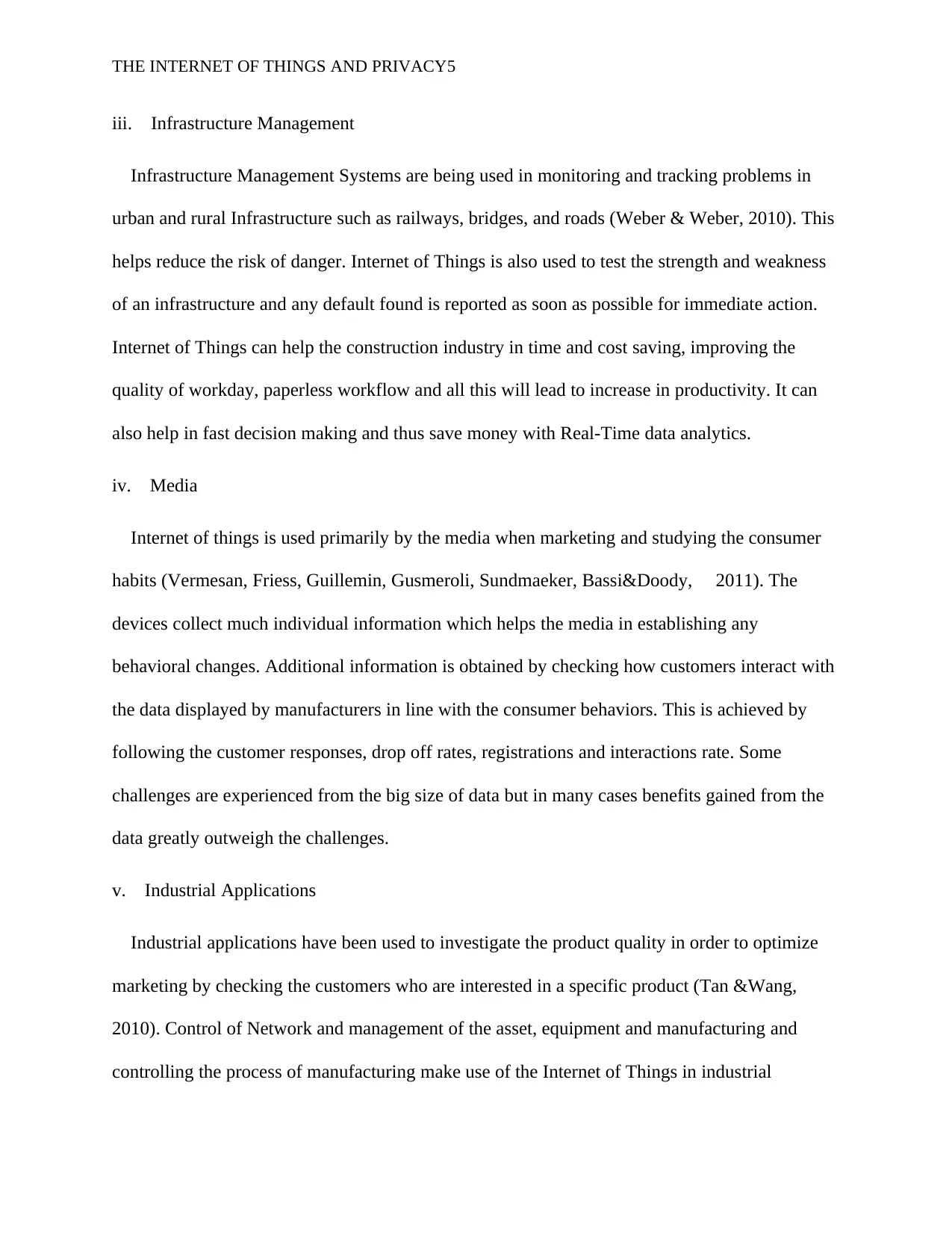
THE INTERNET OF THINGS AND PRIVACY5
iii. Infrastructure Management
Infrastructure Management Systems are being used in monitoring and tracking problems in
urban and rural Infrastructure such as railways, bridges, and roads (Weber & Weber, 2010). This
helps reduce the risk of danger. Internet of Things is also used to test the strength and weakness
of an infrastructure and any default found is reported as soon as possible for immediate action.
Internet of Things can help the construction industry in time and cost saving, improving the
quality of workday, paperless workflow and all this will lead to increase in productivity. It can
also help in fast decision making and thus save money with Real-Time data analytics.
iv. Media
Internet of things is used primarily by the media when marketing and studying the consumer
habits (Vermesan, Friess, Guillemin, Gusmeroli, Sundmaeker, Bassi&Doody, 2011). The
devices collect much individual information which helps the media in establishing any
behavioral changes. Additional information is obtained by checking how customers interact with
the data displayed by manufacturers in line with the consumer behaviors. This is achieved by
following the customer responses, drop off rates, registrations and interactions rate. Some
challenges are experienced from the big size of data but in many cases benefits gained from the
data greatly outweigh the challenges.
v. Industrial Applications
Industrial applications have been used to investigate the product quality in order to optimize
marketing by checking the customers who are interested in a specific product (Tan &Wang,
2010). Control of Network and management of the asset, equipment and manufacturing and
controlling the process of manufacturing make use of the Internet of Things in industrial
iii. Infrastructure Management
Infrastructure Management Systems are being used in monitoring and tracking problems in
urban and rural Infrastructure such as railways, bridges, and roads (Weber & Weber, 2010). This
helps reduce the risk of danger. Internet of Things is also used to test the strength and weakness
of an infrastructure and any default found is reported as soon as possible for immediate action.
Internet of Things can help the construction industry in time and cost saving, improving the
quality of workday, paperless workflow and all this will lead to increase in productivity. It can
also help in fast decision making and thus save money with Real-Time data analytics.
iv. Media
Internet of things is used primarily by the media when marketing and studying the consumer
habits (Vermesan, Friess, Guillemin, Gusmeroli, Sundmaeker, Bassi&Doody, 2011). The
devices collect much individual information which helps the media in establishing any
behavioral changes. Additional information is obtained by checking how customers interact with
the data displayed by manufacturers in line with the consumer behaviors. This is achieved by
following the customer responses, drop off rates, registrations and interactions rate. Some
challenges are experienced from the big size of data but in many cases benefits gained from the
data greatly outweigh the challenges.
v. Industrial Applications
Industrial applications have been used to investigate the product quality in order to optimize
marketing by checking the customers who are interested in a specific product (Tan &Wang,
2010). Control of Network and management of the asset, equipment and manufacturing and
controlling the process of manufacturing make use of the Internet of Things in industrial
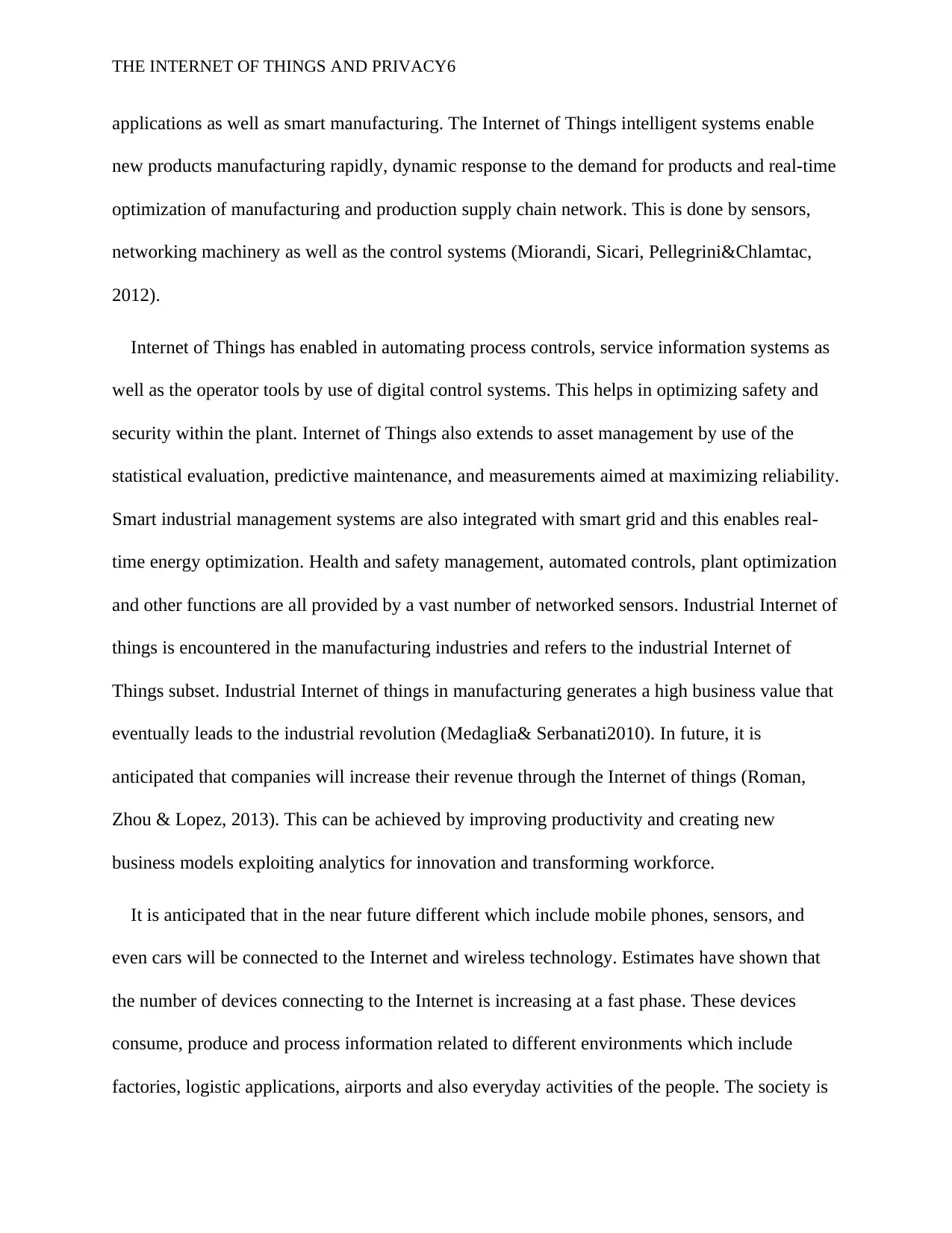
THE INTERNET OF THINGS AND PRIVACY6
applications as well as smart manufacturing. The Internet of Things intelligent systems enable
new products manufacturing rapidly, dynamic response to the demand for products and real-time
optimization of manufacturing and production supply chain network. This is done by sensors,
networking machinery as well as the control systems (Miorandi, Sicari, Pellegrini&Chlamtac,
2012).
Internet of Things has enabled in automating process controls, service information systems as
well as the operator tools by use of digital control systems. This helps in optimizing safety and
security within the plant. Internet of Things also extends to asset management by use of the
statistical evaluation, predictive maintenance, and measurements aimed at maximizing reliability.
Smart industrial management systems are also integrated with smart grid and this enables real-
time energy optimization. Health and safety management, automated controls, plant optimization
and other functions are all provided by a vast number of networked sensors. Industrial Internet of
things is encountered in the manufacturing industries and refers to the industrial Internet of
Things subset. Industrial Internet of things in manufacturing generates a high business value that
eventually leads to the industrial revolution (Medaglia& Serbanati2010). In future, it is
anticipated that companies will increase their revenue through the Internet of things (Roman,
Zhou & Lopez, 2013). This can be achieved by improving productivity and creating new
business models exploiting analytics for innovation and transforming workforce.
It is anticipated that in the near future different which include mobile phones, sensors, and
even cars will be connected to the Internet and wireless technology. Estimates have shown that
the number of devices connecting to the Internet is increasing at a fast phase. These devices
consume, produce and process information related to different environments which include
factories, logistic applications, airports and also everyday activities of the people. The society is
applications as well as smart manufacturing. The Internet of Things intelligent systems enable
new products manufacturing rapidly, dynamic response to the demand for products and real-time
optimization of manufacturing and production supply chain network. This is done by sensors,
networking machinery as well as the control systems (Miorandi, Sicari, Pellegrini&Chlamtac,
2012).
Internet of Things has enabled in automating process controls, service information systems as
well as the operator tools by use of digital control systems. This helps in optimizing safety and
security within the plant. Internet of Things also extends to asset management by use of the
statistical evaluation, predictive maintenance, and measurements aimed at maximizing reliability.
Smart industrial management systems are also integrated with smart grid and this enables real-
time energy optimization. Health and safety management, automated controls, plant optimization
and other functions are all provided by a vast number of networked sensors. Industrial Internet of
things is encountered in the manufacturing industries and refers to the industrial Internet of
Things subset. Industrial Internet of things in manufacturing generates a high business value that
eventually leads to the industrial revolution (Medaglia& Serbanati2010). In future, it is
anticipated that companies will increase their revenue through the Internet of things (Roman,
Zhou & Lopez, 2013). This can be achieved by improving productivity and creating new
business models exploiting analytics for innovation and transforming workforce.
It is anticipated that in the near future different which include mobile phones, sensors, and
even cars will be connected to the Internet and wireless technology. Estimates have shown that
the number of devices connecting to the Internet is increasing at a fast phase. These devices
consume, produce and process information related to different environments which include
factories, logistic applications, airports and also everyday activities of the people. The society is
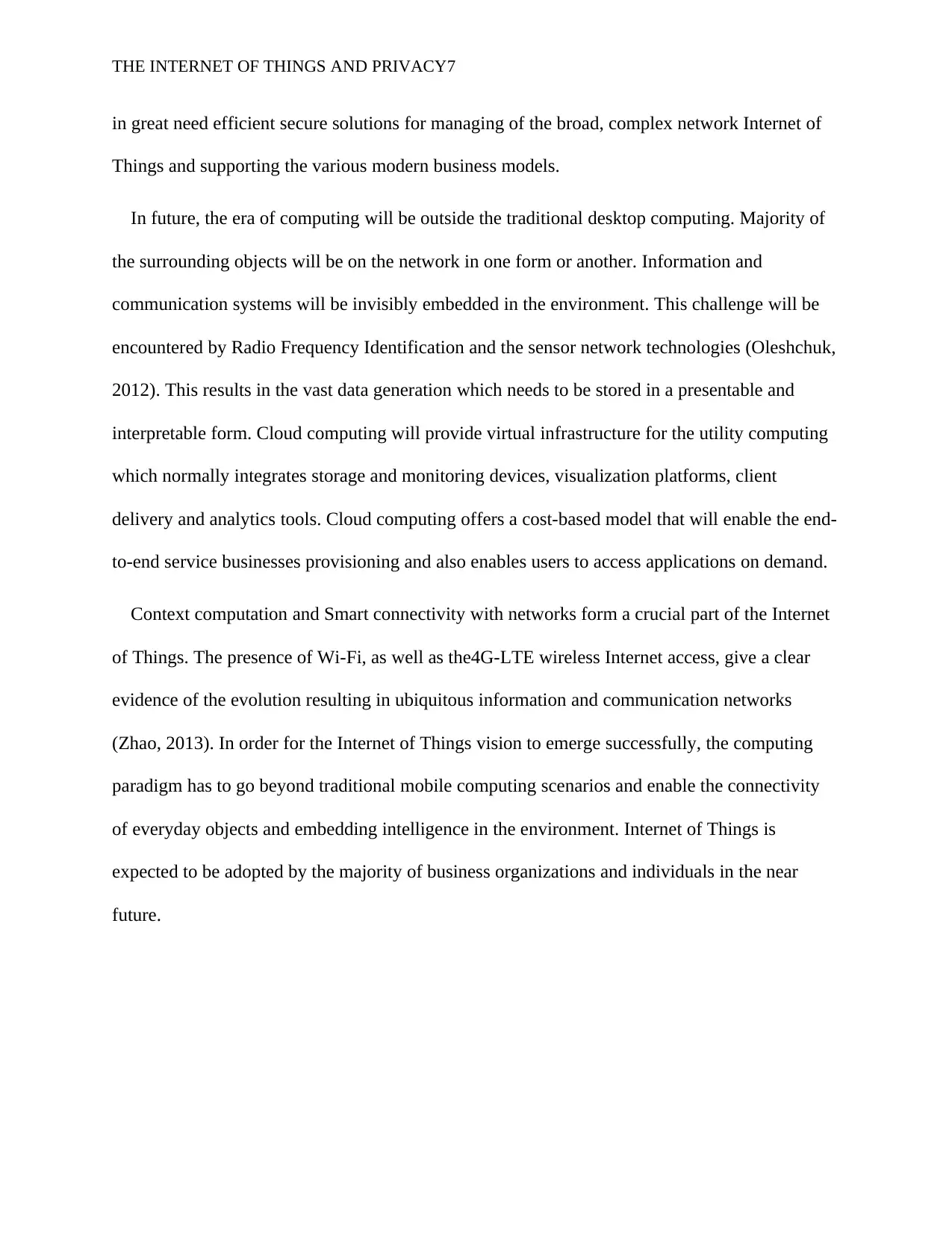
THE INTERNET OF THINGS AND PRIVACY7
in great need efficient secure solutions for managing of the broad, complex network Internet of
Things and supporting the various modern business models.
In future, the era of computing will be outside the traditional desktop computing. Majority of
the surrounding objects will be on the network in one form or another. Information and
communication systems will be invisibly embedded in the environment. This challenge will be
encountered by Radio Frequency Identification and the sensor network technologies (Oleshchuk,
2012). This results in the vast data generation which needs to be stored in a presentable and
interpretable form. Cloud computing will provide virtual infrastructure for the utility computing
which normally integrates storage and monitoring devices, visualization platforms, client
delivery and analytics tools. Cloud computing offers a cost-based model that will enable the end-
to-end service businesses provisioning and also enables users to access applications on demand.
Context computation and Smart connectivity with networks form a crucial part of the Internet
of Things. The presence of Wi-Fi, as well as the4G-LTE wireless Internet access, give a clear
evidence of the evolution resulting in ubiquitous information and communication networks
(Zhao, 2013). In order for the Internet of Things vision to emerge successfully, the computing
paradigm has to go beyond traditional mobile computing scenarios and enable the connectivity
of everyday objects and embedding intelligence in the environment. Internet of Things is
expected to be adopted by the majority of business organizations and individuals in the near
future.
in great need efficient secure solutions for managing of the broad, complex network Internet of
Things and supporting the various modern business models.
In future, the era of computing will be outside the traditional desktop computing. Majority of
the surrounding objects will be on the network in one form or another. Information and
communication systems will be invisibly embedded in the environment. This challenge will be
encountered by Radio Frequency Identification and the sensor network technologies (Oleshchuk,
2012). This results in the vast data generation which needs to be stored in a presentable and
interpretable form. Cloud computing will provide virtual infrastructure for the utility computing
which normally integrates storage and monitoring devices, visualization platforms, client
delivery and analytics tools. Cloud computing offers a cost-based model that will enable the end-
to-end service businesses provisioning and also enables users to access applications on demand.
Context computation and Smart connectivity with networks form a crucial part of the Internet
of Things. The presence of Wi-Fi, as well as the4G-LTE wireless Internet access, give a clear
evidence of the evolution resulting in ubiquitous information and communication networks
(Zhao, 2013). In order for the Internet of Things vision to emerge successfully, the computing
paradigm has to go beyond traditional mobile computing scenarios and enable the connectivity
of everyday objects and embedding intelligence in the environment. Internet of Things is
expected to be adopted by the majority of business organizations and individuals in the near
future.
Paraphrase This Document
Need a fresh take? Get an instant paraphrase of this document with our AI Paraphraser
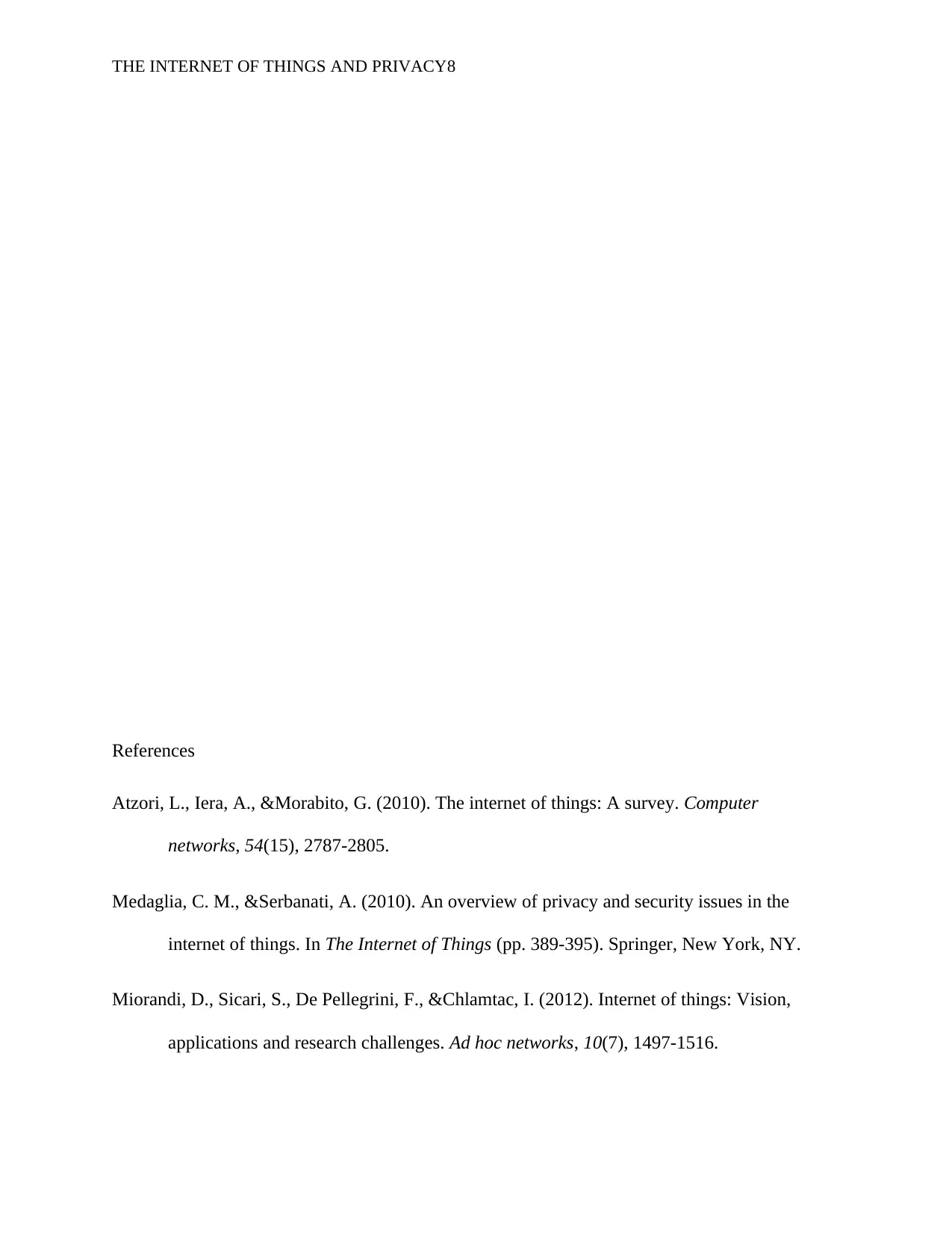
THE INTERNET OF THINGS AND PRIVACY8
References
Atzori, L., Iera, A., &Morabito, G. (2010). The internet of things: A survey. Computer
networks, 54(15), 2787-2805.
Medaglia, C. M., &Serbanati, A. (2010). An overview of privacy and security issues in the
internet of things. In The Internet of Things (pp. 389-395). Springer, New York, NY.
Miorandi, D., Sicari, S., De Pellegrini, F., &Chlamtac, I. (2012). Internet of things: Vision,
applications and research challenges. Ad hoc networks, 10(7), 1497-1516.
References
Atzori, L., Iera, A., &Morabito, G. (2010). The internet of things: A survey. Computer
networks, 54(15), 2787-2805.
Medaglia, C. M., &Serbanati, A. (2010). An overview of privacy and security issues in the
internet of things. In The Internet of Things (pp. 389-395). Springer, New York, NY.
Miorandi, D., Sicari, S., De Pellegrini, F., &Chlamtac, I. (2012). Internet of things: Vision,
applications and research challenges. Ad hoc networks, 10(7), 1497-1516.
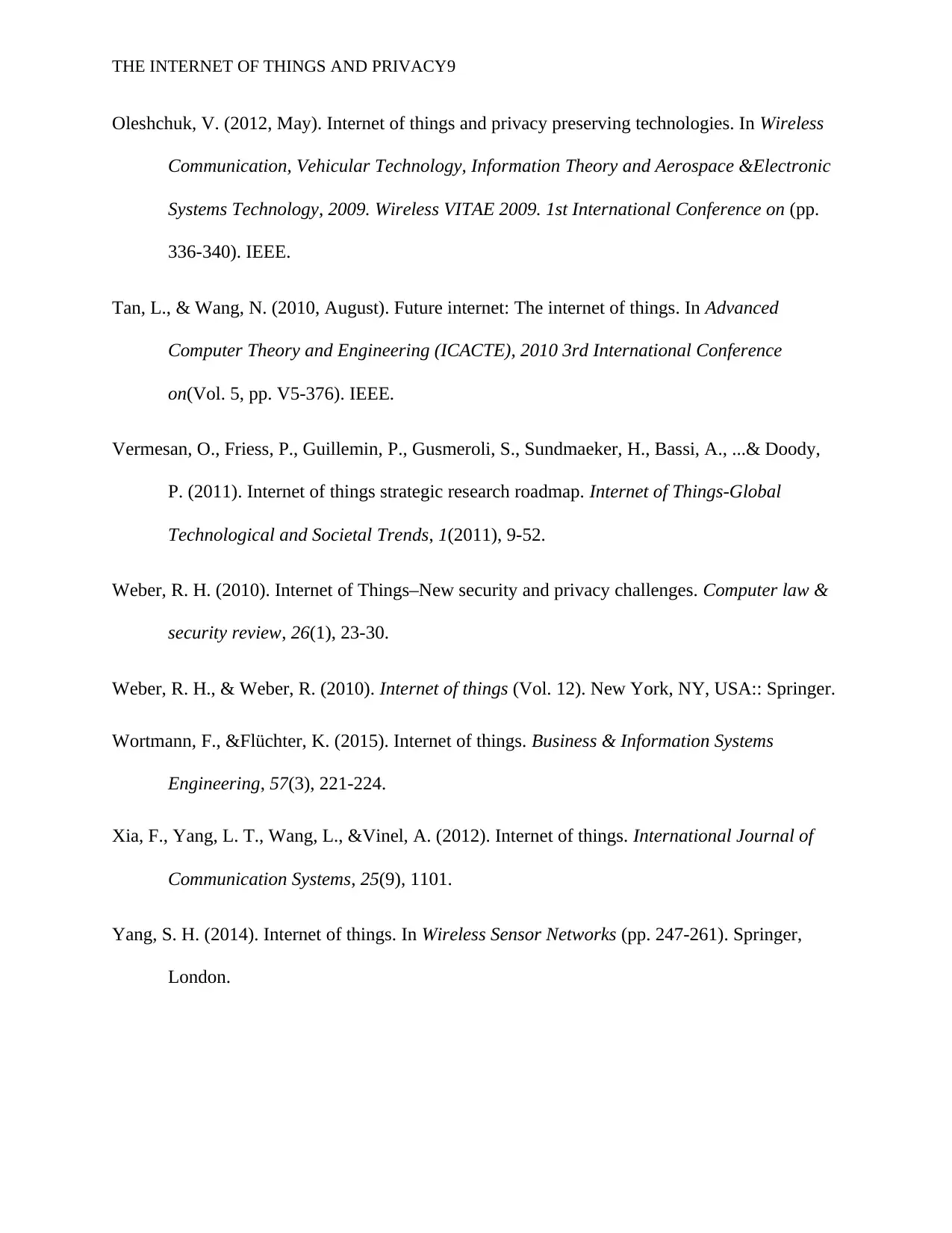
THE INTERNET OF THINGS AND PRIVACY9
Oleshchuk, V. (2012, May). Internet of things and privacy preserving technologies. In Wireless
Communication, Vehicular Technology, Information Theory and Aerospace &Electronic
Systems Technology, 2009. Wireless VITAE 2009. 1st International Conference on (pp.
336-340). IEEE.
Tan, L., & Wang, N. (2010, August). Future internet: The internet of things. In Advanced
Computer Theory and Engineering (ICACTE), 2010 3rd International Conference
on(Vol. 5, pp. V5-376). IEEE.
Vermesan, O., Friess, P., Guillemin, P., Gusmeroli, S., Sundmaeker, H., Bassi, A., ...& Doody,
P. (2011). Internet of things strategic research roadmap. Internet of Things-Global
Technological and Societal Trends, 1(2011), 9-52.
Weber, R. H. (2010). Internet of Things–New security and privacy challenges. Computer law &
security review, 26(1), 23-30.
Weber, R. H., & Weber, R. (2010). Internet of things (Vol. 12). New York, NY, USA:: Springer.
Wortmann, F., &Flüchter, K. (2015). Internet of things. Business & Information Systems
Engineering, 57(3), 221-224.
Xia, F., Yang, L. T., Wang, L., &Vinel, A. (2012). Internet of things. International Journal of
Communication Systems, 25(9), 1101.
Yang, S. H. (2014). Internet of things. In Wireless Sensor Networks (pp. 247-261). Springer,
London.
Oleshchuk, V. (2012, May). Internet of things and privacy preserving technologies. In Wireless
Communication, Vehicular Technology, Information Theory and Aerospace &Electronic
Systems Technology, 2009. Wireless VITAE 2009. 1st International Conference on (pp.
336-340). IEEE.
Tan, L., & Wang, N. (2010, August). Future internet: The internet of things. In Advanced
Computer Theory and Engineering (ICACTE), 2010 3rd International Conference
on(Vol. 5, pp. V5-376). IEEE.
Vermesan, O., Friess, P., Guillemin, P., Gusmeroli, S., Sundmaeker, H., Bassi, A., ...& Doody,
P. (2011). Internet of things strategic research roadmap. Internet of Things-Global
Technological and Societal Trends, 1(2011), 9-52.
Weber, R. H. (2010). Internet of Things–New security and privacy challenges. Computer law &
security review, 26(1), 23-30.
Weber, R. H., & Weber, R. (2010). Internet of things (Vol. 12). New York, NY, USA:: Springer.
Wortmann, F., &Flüchter, K. (2015). Internet of things. Business & Information Systems
Engineering, 57(3), 221-224.
Xia, F., Yang, L. T., Wang, L., &Vinel, A. (2012). Internet of things. International Journal of
Communication Systems, 25(9), 1101.
Yang, S. H. (2014). Internet of things. In Wireless Sensor Networks (pp. 247-261). Springer,
London.
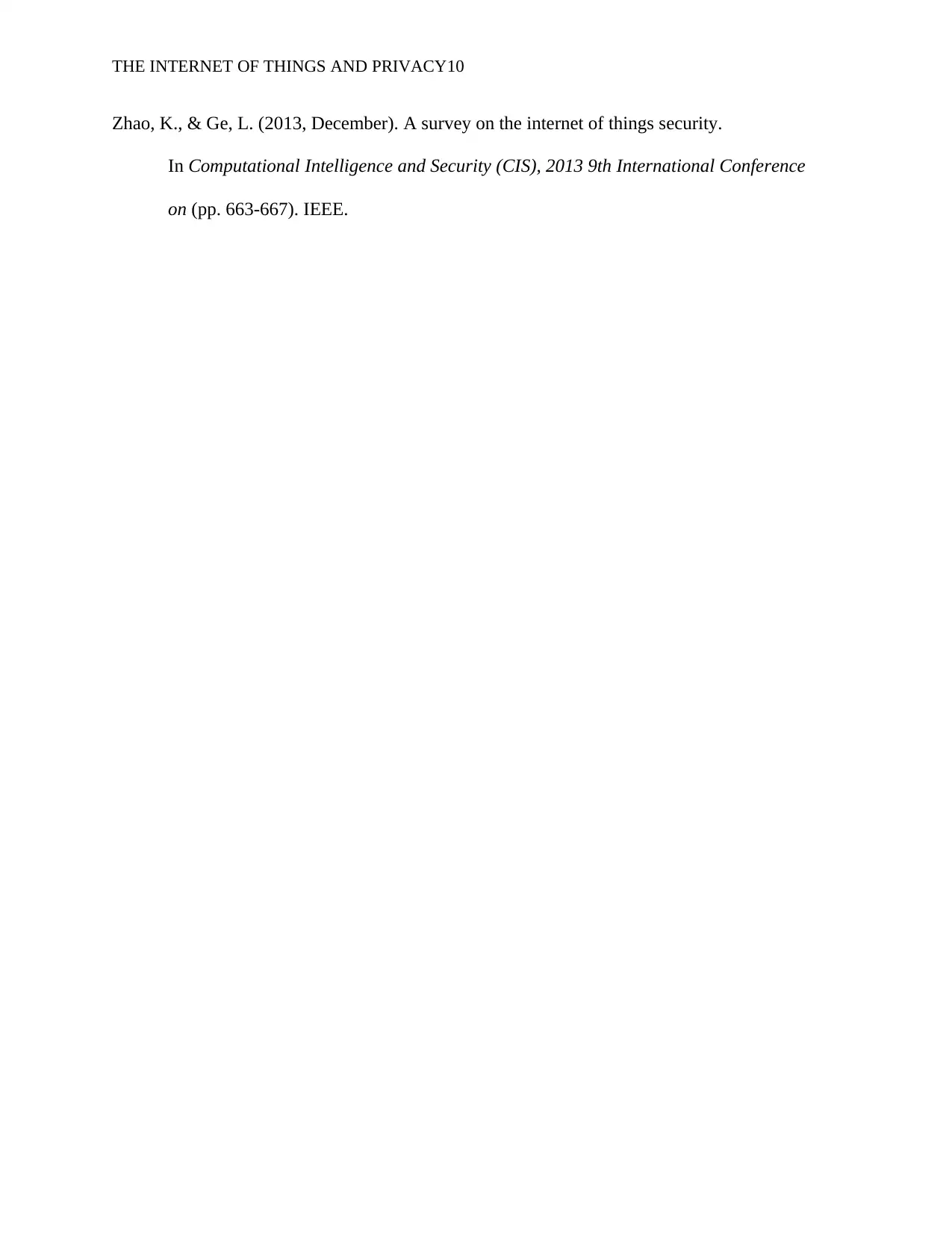
THE INTERNET OF THINGS AND PRIVACY10
Zhao, K., & Ge, L. (2013, December). A survey on the internet of things security.
In Computational Intelligence and Security (CIS), 2013 9th International Conference
on (pp. 663-667). IEEE.
Zhao, K., & Ge, L. (2013, December). A survey on the internet of things security.
In Computational Intelligence and Security (CIS), 2013 9th International Conference
on (pp. 663-667). IEEE.
1 out of 10
Related Documents
Your All-in-One AI-Powered Toolkit for Academic Success.
+13062052269
info@desklib.com
Available 24*7 on WhatsApp / Email
![[object Object]](/_next/static/media/star-bottom.7253800d.svg)
Unlock your academic potential
© 2024 | Zucol Services PVT LTD | All rights reserved.





